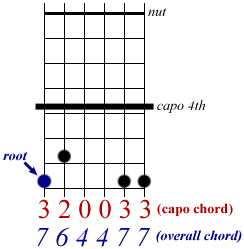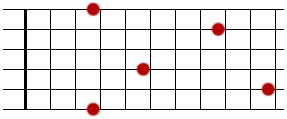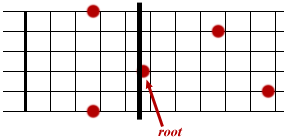
Capo Chord Equivalents
Many people have asked about the chord equivalents when using a capo.
This page is designed to teach you what chords are what when
using a capo. If you don't know what a capo is or how to use one,
check out my page on using a capo.
If you have questions after reading this page,
e-mail me.
Capos are used to change the key of the guitar. They are used because some keys
(for example, the ubiquitous key of G) are easier to play in than others
(for example, the never-encountered key of Eb). But when you are using
that capo, what key are you really playing in? What chords are you really playing?
This may not matter if you are just playing by yourself, but if you want to play
with a pianist or with a guitarist using "harmony" voicings, you'd better figure it out.
That's what this page will tell you! I will work in two directions, both equally useful.
First, I will teach you figure out what key you are in using the capo. Then I will tell
you how to transpose the chords to a song to capo chords, without changing the overall
key to the song. It may be helpful if you knew the notes on the 5th and 6th strings.
The diagram below shows these notes up to the 12th fret.

There are two terms I wish to define before we move on. Overall Key
refers to the key that a song would be played in if there were no capo.
Capo Key refers to the key you are playing in while using the capo.
Overall Chords and Capo Chords have the same connotation in reference
to the chords being played.
What Key Am I Really In?
All right, let's say we're playing this progression with a capo on the 4th fret:
GAmCD
You learned from my lesson on keys that this is a I-ii-IV-V
progression in G. So your capo key is G. You are playing on the 4th fret.
The G chord you are playing looks like this:

The root of a 320033 G chord appears on the sixth string
3rd fret; that note is, of course, a G. In our capo G, the root still
appears on the sixth string. However, with the capo, as shown above, this root
appears on the 7th fret. That note is a B. Therefore, this progression
in G with a capo at the fourth fret is in the overall key of B. So if you wanted to play
it without the capo, you just need a I-ii-IV-V progression in B:
BC#mEF#
Play both these progressions: in G with Capo 4th and then in B without a capo,
and you will see that the chords are the same! So the four things you need to do
to determine what overall key you are in when using a capo are listed below.
That's it!
- Determine what Capo Key you are playing in.
- Determine where the root of that key normally appears
(in G, that's sixth string 3rd fret).
- Determine where that root note appears with the capo on
(in G with capo 4th, that's sixth string 7th fret).
- Determine what note that is (sixth string 7th fret is a B), and that's your Overall Key.
What Key Am I Really In?
All right, I'm gonna make this easy. Let's say we're playing this
progression without a capo:
GAmCD
You learned from my lesson on keys that this is a I-ii-IV-V
progression in G. So your overall key is G. Let's say you want your three best friends
to do some chord harmony with you: you want them to play the same overall key but
with capos on four different frets. Each of you will be playing in a different capo key,
but you will all sound good because you are all playing in the same overall key.
So let's get to it!
Your first friend is playing with a capo on the third fret. What capo key should he play in?
Well, you are playing in G. Therefore, the root note of whatever capo key he plays in
must be an overall G. On the fretboard, G falls in these places:

With the capo 3rd, that looks like this:

With the capo 3rd, the root appears on the open sixth string.
The major chord with a root note on the open sixth string is an E chord, 022100.
So the friend with capo 3rd should play I-ii-IV-V in the capo key of E:
EF#mAB
Does this make sense? Take the capo off and play a G barre chord 355433. Look at the
shape: it looks exactly like an E chord with capo 3rd (that barring finger acts just
like a capo). Now try playing both progressions: in G without the capo, then in E
with capo 3rd. It'll sound perfect.
Now we move to the friend who wants to play with capo 5th. The fretboard
with capo 5th looks like this:

With the capo 5th, the root appears on the open fourth string.
The major chord with a root note on the open fourth string is a D chord, xx0232.
So the friend with capo 5th should play I-ii-IV-V in the capo key of D:
DEmGA
Does this make sense? Take the capo off and play a D barre chord x57775 (D is
the last chord in the original progression). Look at the
shape: it looks exactly like an A chord with capo 5th, the same chord you
play as the last chord in the capo 5th progression.
All right, now the last friend, Don Felder, wants to play with capo 7th
(after the succes of Hotel California he couldn't stop playing up there).
The fretboard with capo 7th looks like this:

With the capo 7th, the root appears on the fifth string 3rd fret.
The major chord with a root note on the fifth string 3rd fret is a C chord, x32010.
So the friend with capo 7th should play I-ii-IV-V in the capo key of C:
CDmFG
Does this make sense? This one's a bit harder to show, but it still does.
Take the capo off and play a C barre chord (8 10 10 9 8 8) (C is
the third chord in the original progression). Look at the
shape: it looks exactly like an F chord with capo 7th, the same chord you
play as the third chord in the capo 7th progression.
All right, now you've got it. Here are the steps to figuring out a capo key from
an overall key:
- Determine what Overall Key you are playing in.
- Determine where the root notes of that key appear all the way up the fretboard.
- Put on the capo, and find the lowest root note. Note that position in your mind.
- Decide what major chord has its root note in that location, and that's your Capo Key.
One final note: not all capo positions will work well. Like I mentioned above,
you may end up trying to play in Eb. Just experiment and remember to use your head.
I hope this helps! If you have any more questions, feel free to
e-mail me. And have fun doing chord harmonizations
with Mr. Felder :)
Back to Dansm's Guitar Chord Theory
You are visitor number
 since 3-26-97
since 3-26-97
© 1998 Daniel E. Smith.





